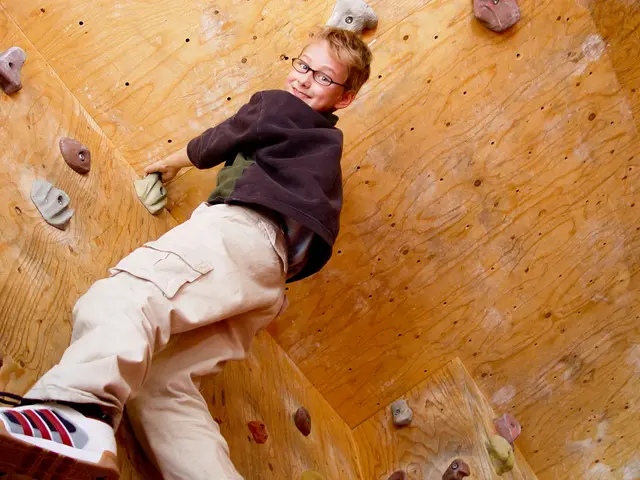Top nine sun-loving blooms Ideal for a captivating butterfly haven
Transforming a humble outdoor space into a lively butterfly paradise is a whimsical way to summon an array of animated pollinators like butterflies, bees, and even hummingbirds. By planting a medley of captivating perennials such as bee balm, butterfly bush, black-eyed Susan, and milkweed, you not only craft a visually alluring garden but also bolster the very ecosystems these winged creatures depend on. For instance, yellow-blooming perennials and purple coneflowers are beckoning feasts that attract monarch butterflies, offering them both nectar and host plants.
Whether you're a seasoned gardening whiz or a fledgling plant parent, opting for hardy plants like asters, yarrow, and phlox can transform your garden into a year-round haven for these vibrant insects. These plants are not only eye-catching, but they also lend a supporting hand to our cherished garden inhabitants.
Without further ado, here are some of the top perennials perfect for a lively butterfly garden:
Top Pollinator Picks
1. Blanket Flower
This radiant plant is a top choice for butterfly enthusiasts. A blanket flower optimally thrives in well-drained soil, full sun, and warm summers. Established plants don't require much watering, so don't forget to water for the first few weeks after planting if rainfall is scarce. This fiery bloomer also has medicinal properties—its root tea may soothe a range of ailments, from gastroenteritis to skin disorders [source 1].
2. New England Aster
Appealing to the Pearl Crescent butterfly, this aster serves not only as a nectar source but also as a host plant for caterpillars. By providing support at both stages, this plant stands out among other pollinator-friendly options. Asters also have a rich history in traditional Chinese medicine, wherein they were used to treat various ailments, including pain, fevers, diarrhea, and weak skin [source 2].
3. Joe-Pye Weed
This long-blooming perennial is irresistible to butterflies and bees, making it a true garden treasure. Native to wet meadows in the eastern half of the US, Joe Pye Weed flourishes in supporting a myriad of pollinators, would–be garden heroes, and moth and butterfly caterpillars [source 3].
4. Garden Phlox
With its sweet perfume wafting through the air, phlox lures a variety of butterflies. Featuring both upright and creeping varieties, phlox adds a burst of color and interest to the summer garden. Native Americans used the roots of phlox to treat diarrhea, and the entire plant was used to remedy problems with the stomach [source 4].
5. Purple Coneflower
Well-known for its attractive blooms and butterfly magnet capabilities, purple coneflower also has a long-standing history in herbal medicine. Colds, coughs, bronchitis, upper respiratory infections, and inflammatory conditions have all been treated with purple coneflower [source 5].
6. Tickseed
An excellent staple for a pollinator garden, tickseed blooms prolifically, luring a host of pollinators. Choose from extensive varieties of coreopsis like 'Moonbeam' and 'Zagreb', each one offering its own unique charm. Native Americans used root tea for diarrhea and as an emetic, and they also consumed dried tops in tea to strengthen their blood [source 6].
7. Blazing Star
The photogenic blazing star boasts clusters of feathery purple or white flowers adorning long stalks, resulting in a mesmerizing display. These aptly named flowers will thrive best in full sun and well-draining soil with low to medium fertility. With strong medicinal properties, the roots were ground and used as a pain reliever in the US [source 7].
8. Goldenrod
This hardy perennial not only carpets the ground magnificently but also supports specialist bees and attracts butterflies, moths, beetles, and solitary wasps. Once ubiquitous in American medicinal practices, goldenrod has been traditionally used to treat tuberculosis, diabetes, enlargement of the liver, gout, hemorrhoids, internal bleeding, asthma, and arthritis [source 8].
9. Butterfly Weed
Monarch butterflies capitalize on the nectar-rich blooms of butterfly weed, choosing from among various milkweed species for caterpillar sustenance. Butterfly weed needs full sun and prefers sandy soil, but it can grow in almost any type of soil, as long as it is well-drained [source 9]. The roots of butterfly weed have been used as a cure for pleurisy and other pulmonary ailments [source 10].
And remember, fostering a local ecosystem is not just a delightful endeavor; it's an indispensable contribution that promises many seasons of enchantment. Craft your garden masterpiece with sun-loving perennials like Echinacea, Black-eyed Susan, bee balm, sedum, echinacea purpurea, Asclepias tuberosa, and Phlox paniculata for sunny spots and shaded areas, and watch your garden transform into a symphony of fluttering pollinators. Happy gardening!
[Sources]1. https://aggie-horticulture.tamu.edu/galveston/ficus/germander-broad-leaf-archangel/germander.html2. https://www.americasforests.org/all-about-trees/plants/rose-autumn-mallow-hibiscus-moscheutos/3. https://www.missouribotanicalgarden.org/PlantFinder/PlantFinderDetails.aspx?id=635394. https://www.missouribotanicalgarden.org/PlantFinder/PlantFinderDetails.aspx?id=871835. https://en.wikipedia.org/wiki/Echinacea6. https://native-plantsave-nations.com/coreopsis-tickseed/7. https://www.hort.purdue.edu/newcrop/misc/plant_reports/blazingstar/hbz_blazingstar.html8. https://www.anniesremedy.com/herb_detail13.php9. https://u.osu.edu/osubugs/2015/06/03/butterfly-weed-asclepias-tuberosa/10. https://www.herblore.com/garden/butterfly_garden.htm
- Incorporating cooking recipes that feature these pollinator-friendly plants into your lifestyle can introduce unique flavors to your meals, creating a harmonious fusion of food and gardening.
- Nurturing a butterfly garden not only elevates your home-and-garden lifestyle but also fosters a sustainable approach to lifestyle choices, contributing to environmental conservation.
- Embrace fashion-and-beauty trends centered on eco-friendly and animal-friendly materials, aligning your lifestyle with your love for butterflies and pollinators.
- Food-and-drink establishments can support local ecosystems by sourcing ingredients from sustainable farms that prioritize pollinator-friendly practices.
- Reflect on family-dynamics and the importance of teaching children the value of pollinators and conservation efforts, inspiring them to adopt environmentally responsible habits.
- A well-tended butterfly garden can serve as an excellent subject for photographs, providing an organic backdrop for family portraits and personal moments.
- Hosting gatherings in a butterfly-friendly outdoor space can create memorable moments, as guests delight in the spectacle of these winged creatures.
- Engaging in gardening activities such as planting, watering, and deadheading can promote mindfulness and stress relief, contributing to personal-growth and mental well-being.
- Shopping for garden tools, supplies, and plants that support local businesses and pollinator-friendly initiatives aligns with ethical shopping practices.
- Regular car-maintenance and choosing eco-friendly cars like electric vehicles contribute to environmental conservation, reflecting a lifestyle tuned to our shared concern for the planet.
- Carrying out productive tasks in a butterfly garden, such as reading, writing, or working on a laptop, transforms mundane activities into enchanting experiences.
- Developing a career centered on championing pollinator-friendly practices and conservation efforts can lead to rewarding opportunities in fields such as agriculture, environmental conservation, and landscape architecture.
- Seizing adventures that involve exploring diverse global cuisines expands our knowledge of local plants and their significance to pollinators.
- Instead of traditional vacations, opt for online education courses that focus on pollinator-friendly gardening, enhancing your lifestyle, and furthering your personal-growth.
- Job-search platforms can prioritize companies with strong environmental and pollinator-friendly initiatives, allowing workers to make choices that align with their values.
- Cultural travel experiences that involve immersing oneself in traditional gardening practices and observing local pollinators enrich our understanding of diverse lifestyles.
- Budget-travel options such as backpacking and hostel stays can provide an opportunity to engage in gardening activities, such as helping in community gardens or volunteering at nature reserves.
- Learning about different pollinator species, lifecycles, and their needs can equip us with the knowledge necessary for creating thriving pollinator habitats.
- Goal-setting becomes a purposeful exercise when it includes the intention to create and nurture a butterfly garden that supports a multitude of pollinators.
- Pursuing lifelong learning by regularly researching and experimenting with new gardening techniques and strategies strengthens our relationship with nature.
- Skills-training courses in gardening, pollinator identification, and sustainable practices help advance personal-growth and support environmental conservation.
- Engaging in sports like football, soccer, WNBA, baseball, hockey, golf, tennis, auto-racing, or mixed martial arts can provide opportunities to learn about pollinator-friendly initiatives and their impact on the sports industry.
- Accounting for the presence of pollinators and their habitat in sports venues, such as stadiums or race tracks, can inspire sustainable practices within these spaces.
- Following European leagues such as the English Premier League, Spanish La Liga, or the French Ligue 1 can provide insight into the integration of environmental and social responsibilities within these organizations.
- Educational institutions like NCAA basketball programs can incorporate pollinator-friendly initiatives into their sports and campus landscaping practices.
- Choosing grassroots, eco-friendly versions of major sports like Masters, Grand Prix, horse racing, Serie A, or Laliga reflects a lifestyle commitment to sustainability and conservation.
- Seeking alternative forms of entertainment, such as attending major sporting events that prioritize sustainability initiatives, enhances our personal growth by aligning our leisure activities with our values.
- Collaborating with local communities and organizations in the planning and implementation of a butterfly garden reinforces the importance of collective action and cooperation in addressing conservation issues.








